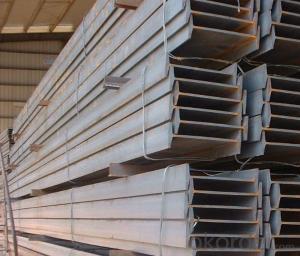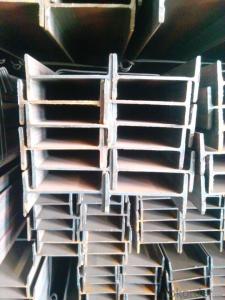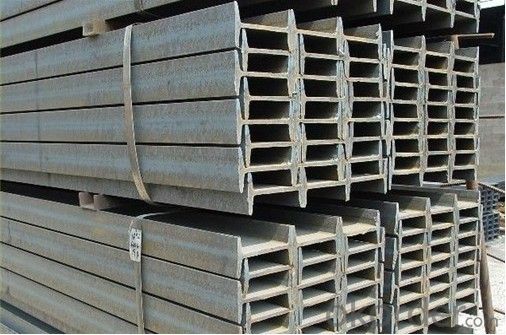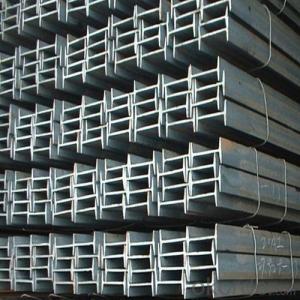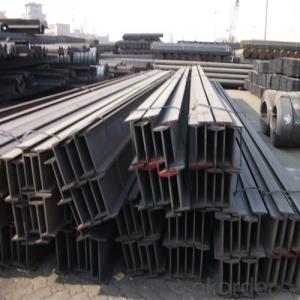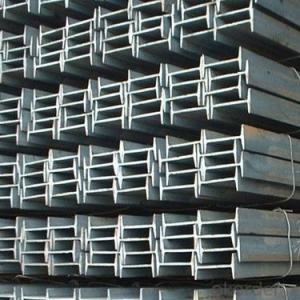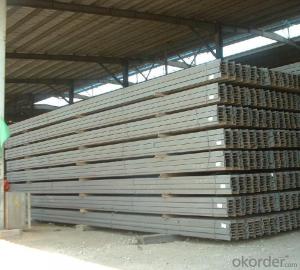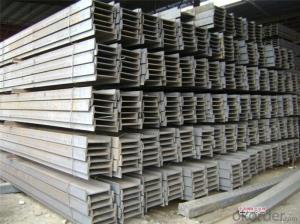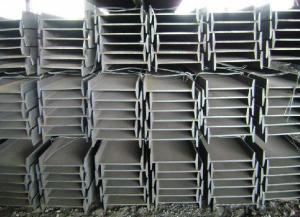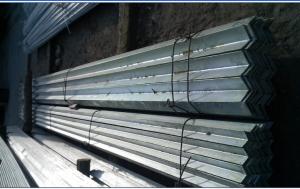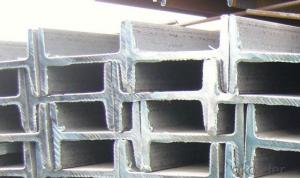Hot Rolled IPE and IPEAA Beams Grade Q235 Steel I-Beams
- Loading Port:
- Tianjin
- Payment Terms:
- TT or LC
- Min Order Qty:
- 25 m.t.
- Supply Capability:
- 10000 m.t./month
OKorder Service Pledge
OKorder Financial Service
You Might Also Like
OKorder is offering high quality Hot Rolled Steel I-Beams at great prices with worldwide shipping. Our supplier is a world-class manufacturer of steel, with our products utilized the world over. OKorder annually supplies products to European, North American and Asian markets. We provide quotations within 24 hours of receiving an inquiry and guarantee competitive prices.
Product Applications:
Hot Rolled Steel I-Beams are ideal for structural applications and are widely used in the construction of buildings and bridges, and the manufacturing, petrochemical, and transportation industries.
Product Advantages:
OKorder's Steel I-Beams are durable, strong, and resist corrosion.
Main Product Features:
· Premium quality
· Prompt delivery & seaworthy packing (30 days after receiving deposit)
· Corrosion resistance
· Can be recycled and reused
· Mill test certification
· Professional Service
· Competitive pricing
Product Specifications:
Manufacture: Hot rolled
Grade: Q195 – 235
Certificates: ISO, SGS, BV, CIQ
Length: 6m – 12m, as per customer request
Packaging: Export packing, nude packing, bundled
Chinese Standard (H*W*T) | Weight (Kg/m) | 6m (pcs/ton) | Light I (H*W*T) | Weight (Kg/m) | 6m (pcs/ton) | Light II (H*W*T) | Weight (Kg/m) | 6M |
100*68*4.5 | 11.261 | 14.8 | 100*66*4.3 | 10.13 | 16.4 | 100*64*4 | 8.45 | 19.7 |
120*74*5.0 | 13.987 | 11.9 | 120*72*4.8 | 12.59 | 13.2 | 120*70*4.5 | 10.49 | 15.8 |
140*80*5.5 | 16.89 | 9.8 | 140*78*5.3 | 15.2 | 10.9 | 140*76*5 | 12.67 | 13.1 |
160*88*6 | 20.513 | 8.1 | 160*86*5.8 | 18.46 | 9 | 160*84*5.5 | 15.38 | 10.8 |
180*94*6.5 | 24.143 | 6.9 | 180*92*6.3 | 21.73 | 7.6 | 180*90*6 | 18.11 | 9.2 |
200*100*7 | 27.929 | 5.9 | 200*98*6.8 | 25.14 | 6.6 | 200*96*6.5 | 20.95 | 7.9 |
220*110*7.5 | 33.07 | 5 | 220*108*7.3 | 29.76 | 5.6 | 220*106*7 | 24.8 | 6.7 |
250*116*8 | 38.105 | 4.3 | 250*114*7.8 | 34.29 | 4.8 | 250*112*7.5 | 28.58 | 5.8 |
280*122*8.5 | 43.492 | 3.8 | 280*120*8.2 | 39.14 | 4.2 | 280*120*8 | 36.97 | 4.5 |
300*126*9 | 48.084 | 3.4 | 300*124*9.2 | 43.28 | 3.8 | 300*124*8.5 | 40.87 | 4 |
320*130*9.5 | 52.717 | 3.1 | 320*127*9.2 | 48.5 | 3.4 | |||
360*136*10 | 60.037 | 2.7 | 360*132*9.5 | 55.23 | 3 |
FAQ:
Q1: Why buy Materials & Equipment from OKorder.com?
A1: All products offered byOKorder.com are carefully selected from China's most reliable manufacturing enterprises. Through its ISO certifications, OKorder.com adheres to the highest standards and a commitment to supply chain safety and customer satisfaction.
Q2: How do we guarantee the quality of our products?
A2: We have established an advanced quality management system which conducts strict quality tests at every step, from raw materials to the final product. At the same time, we provide extensive follow-up service assurances as required.
Q3: How soon we can delivery the goods ?
A3: We have a mill with 20000mts of capacity per month. We can delivery the goods within in one month ,as long as your order quantity less than 20000mts .
Images:
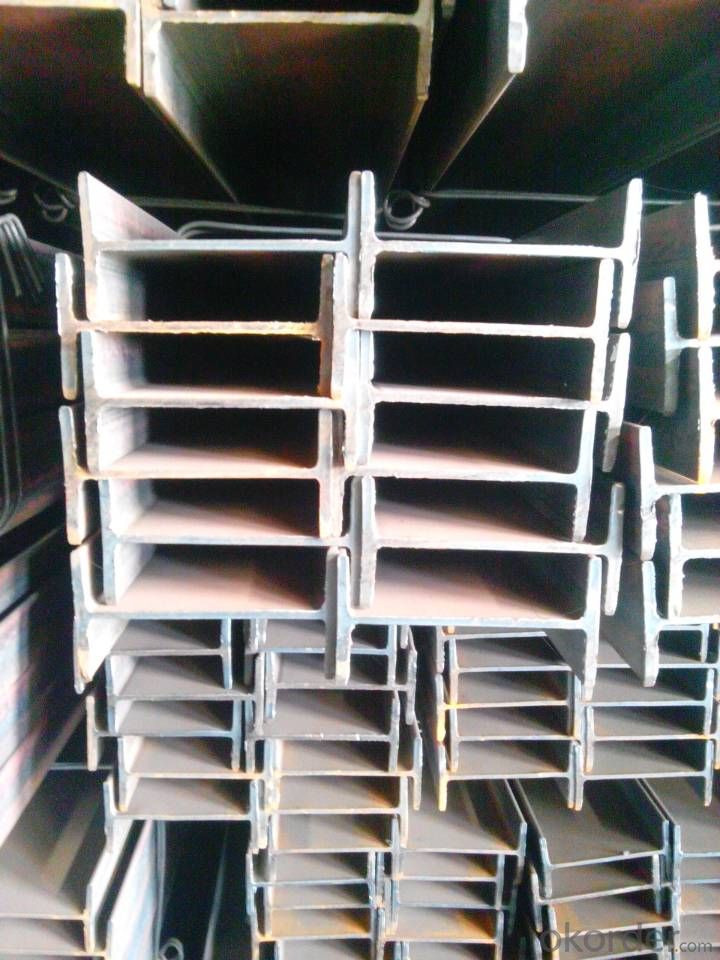

- Q: Are steel I-beams suitable for high-rise building construction?
- Yes, steel I-beams are highly suitable for high-rise building construction. They have been widely used in the construction industry for many decades due to their numerous advantages. Firstly, steel I-beams possess exceptional strength-to-weight ratio, making them ideal for tall structures. They can withstand heavy loads and provide excellent structural support, which is crucial in high-rise buildings. This strength allows for the construction of taller and more spacious buildings without compromising structural integrity. Secondly, steel I-beams are highly durable and resistant to various environmental factors. They can endure extreme weather conditions, seismic activities, and even fire. This durability ensures the longevity and safety of high-rise buildings, providing occupants with a secure living or working environment. Additionally, steel I-beams are versatile and allow for flexible design options. They can be customized to fit specific architectural requirements and building codes. This flexibility enables architects and engineers to create innovative and aesthetically pleasing high-rise structures. Moreover, the use of steel I-beams in high-rise construction allows for faster and more efficient construction processes. Steel is a readily available material, and the prefabricated nature of I-beams makes them easy to transport and assemble on-site. This reduces construction time and costs, making it an attractive option for building owners. Lastly, steel I-beams are sustainable and eco-friendly. Steel is a highly recyclable material, and using it in construction helps reduce the demand for new raw materials. Additionally, steel structures can be dismantled and recycled at the end of their lifespan, minimizing waste and environmental impact. In conclusion, steel I-beams are highly suitable for high-rise building construction due to their exceptional strength, durability, versatility, efficiency, and sustainability. They have proven to be a reliable and cost-effective choice for creating tall and safe structures, making them a preferred option in the construction industry.
- Q: Can Steel I-Beams be used for healthcare facilities like hospitals?
- Yes, Steel I-Beams can be used for healthcare facilities like hospitals. Steel I-Beams are commonly used in construction due to their strength, durability, and ability to support heavy loads. In healthcare facilities, they can provide structural support to the building, ensuring its stability and safety. Additionally, steel is a non-combustible material, making it suitable for hospitals where fire safety is of utmost importance.
- Q: Can steel I-beams be used in hotels or hospitality buildings?
- Yes, steel I-beams can be used in hotels or hospitality buildings. Steel I-beams are commonly used in the construction industry due to their strength and durability. They provide excellent structural support, making them suitable for large-scale structures like hotels and hospitality buildings. Steel I-beams can handle heavy loads and span long distances, allowing for flexible and open floor plans commonly seen in hotels. Additionally, steel is resistant to fire, pests, and rot, making it a safe and reliable choice for construction. The use of steel I-beams in hotels or hospitality buildings ensures the safety and longevity of the structure while also providing the necessary support for various architectural designs.
- Q: Are steel I-beams suitable for supporting rooftop gardens with water features?
- Steel I-beams can be suitable for supporting rooftop gardens with water features, depending on several factors. Steel I-beams are known for their strength and load-bearing capabilities, making them a popular choice for structural support in construction projects. When considering the suitability of steel I-beams for supporting rooftop gardens with water features, it is important to assess the weight and load distribution of the garden and water features. This includes considering the weight of the soil, plants, water reservoirs, and any additional structures such as ponds or fountains. Steel I-beams are designed to withstand heavy loads, and with proper engineering and calculations, they can be adequately sized and positioned to support the weight of a rooftop garden with water features. However, it is crucial to consult with a structural engineer or a qualified professional to ensure that the steel I-beams are properly designed and installed to handle the specific requirements of the rooftop garden. Factors such as the size and span of the I-beams, the distance between supports, and the overall structural integrity of the building must all be taken into consideration. Additionally, the possibility of water leakage or excess moisture should also be evaluated to prevent any potential damage to the steel beams. Furthermore, regular maintenance and inspection of the steel I-beams are essential to ensure their ongoing suitability for supporting rooftop gardens with water features. Regular checks for signs of corrosion, instability, or any structural issues should be conducted to maintain the safety and stability of the rooftop garden. In summary, steel I-beams can be suitable for supporting rooftop gardens with water features, but it is important to consult with a structural engineer or a qualified professional to ensure proper design, installation, and maintenance to ensure the safety and stability of the structure.
- Q: Can steel I-beams be used in both residential and commercial buildings?
- Yes, steel I-beams can be used in both residential and commercial buildings. Steel I-beams are commonly used as structural supports due to their strength, durability, and versatility. They provide excellent load-bearing capabilities, allowing for the construction of large spans and open floor plans. In residential buildings, steel I-beams are often used to support the weight of upper floors and roof structures. In commercial buildings, they are frequently employed in the construction of warehouses, factories, and high-rise buildings. The use of steel I-beams ensures the structural integrity of the building, making them suitable for various applications in both residential and commercial settings.
- Q: Can I use butt welding to weld steel? What are you asking for? What specifications are you looking for?
- Large span single girder crane on the I-beam are welding, the main requirements is docking two I-beam to try to level up, up and down all around and find it, in order to avoid deformation.Without special specifications, we can refer to the contents of the welds in the seventh chapter of the code for design of steel structures.
- Q: How are steel I-beams transported and delivered?
- Steel I-beams are typically transported and delivered using various methods depending on the size and weight of the beams. One common method is by using flatbed trucks or trailers. These trucks are equipped with large, open beds that can accommodate the length and weight of the I-beams. The beams are loaded onto the flatbeds and secured using chains, straps, or other fastening devices to ensure they do not shift during transportation. For longer distances or larger quantities of I-beams, specialized trucks known as lowboys or low-loaders are often employed. These trucks have a lower deck height, allowing for greater clearance when transporting taller or oversized I-beams. Lowboys also have removable goosenecks, which allow for easy loading and unloading of the I-beams. In some cases, if the distance is not too far, steel I-beams can be transported using rail transportation. Specialized railcars, such as flatcars or well cars, are utilized to load and transport the I-beams. This method is especially convenient when delivering large quantities of I-beams to construction sites or steel fabrication facilities located near rail lines. Upon arrival at the destination, the steel I-beams are typically unloaded using cranes or forklifts. Depending on the specific requirements and capabilities of the receiving facility, the beams may be unloaded directly from the truck or transferred to a storage area for later use. Overall, the transportation and delivery of steel I-beams require careful planning and coordination to ensure the beams arrive safely and efficiently. Proper securing and handling techniques are crucial to prevent any damage to the beams during transit.
- Q: What span is the maximum span for I-beam?
- Steel beams as beams, the maximum span should not exceed 7 meters, if the span is now large, the bottom must be propped up with pillars.
- Q: What are the common applications of steel I-beams in construction?
- Steel I-beams are widely used in construction due to their strength, versatility, and durability. They are a crucial component in various structural systems, including buildings, bridges, and industrial facilities. Some common applications of steel I-beams in construction include: 1. Building frames: Steel I-beams are commonly used as primary load-bearing components in building frames. They provide excellent support and stability, allowing for the construction of large and open spaces. I-beams are often used to create the framework for commercial buildings, warehouses, and residential structures. 2. Bridges: Steel I-beams are extensively used in the construction of bridges due to their high strength-to-weight ratio. They can span long distances, making them ideal for bridging rivers, valleys, and highways. I-beams form the structural backbone of bridge decks, supporting the weight of vehicles and pedestrians. 3. Mezzanines: Steel I-beams are utilized in the construction of mezzanine floors, which are intermediate floors between main floors of a building. Mezzanines are commonly found in warehouses, factories, and retail spaces, providing additional storage or workspace. I-beams provide the necessary load-bearing capacity for these elevated platforms. 4. Industrial structures: Steel I-beams are essential in the construction of industrial structures, such as manufacturing plants, refineries, and power plants. They can withstand heavy loads and harsh environmental conditions, making them suitable for supporting heavy machinery, equipment, and storage systems. 5. Roof support: Steel I-beams are used to support the roofs of large structures, such as stadiums, arenas, and exhibition halls. They provide structural integrity and can withstand the weight of the roof materials, as well as any additional loads, such as snow or wind. 6. Cantilevered structures: Steel I-beams are commonly used in cantilevered structures, which are structures that extend horizontally without any additional support at one end. Examples include balconies, canopies, and awnings. I-beams provide the necessary strength and stability to support these extended sections. Overall, steel I-beams are a fundamental component in construction due to their versatility and strength. They are used in a wide range of applications, from building frames and bridges to mezzanines and industrial structures. Steel I-beams play a critical role in ensuring the structural integrity and longevity of various construction projects.
- Q: Can steel I-beams be used in data centers or technology facilities?
- Data centers and technology facilities can indeed utilize steel I-beams for their construction. These beams are widely employed in the building industry because of their exceptional strength and durability. Given the presence of heavy equipment like servers and storage racks in these facilities, it is crucial to have steel I-beams in place to provide the necessary structural support to withstand the weight and load of such equipment. Moreover, steel I-beams offer a range of advantages for data centers and technology facilities. They possess a high load-bearing capacity, ensuring that they can bear heavy loads without any flexing or bending. This is of utmost importance to maintain the stability and safety of the facility. In addition, steel I-beams are resistant to fire, which is especially critical in data centers where the risk of fire can lead to disastrous consequences. The fire-resistant properties of steel I-beams play a vital role in preventing structural collapse and buying valuable time for evacuation or firefighting efforts. Furthermore, steel I-beams have the flexibility to be designed and engineered according to specific requirements and load capacities. This adaptability allows for customization and optimization of the structural design, ensuring that the data center or technology facility can easily accommodate its unique needs and equipment configurations. In summary, steel I-beams are widely relied upon in data centers and technology facilities due to their strength, durability, fire resistance, and ability to be customized for specific requirements.
Send your message to us
Hot Rolled IPE and IPEAA Beams Grade Q235 Steel I-Beams
- Loading Port:
- Tianjin
- Payment Terms:
- TT or LC
- Min Order Qty:
- 25 m.t.
- Supply Capability:
- 10000 m.t./month
OKorder Service Pledge
OKorder Financial Service
Similar products
Hot products
Hot Searches
Related keywords

